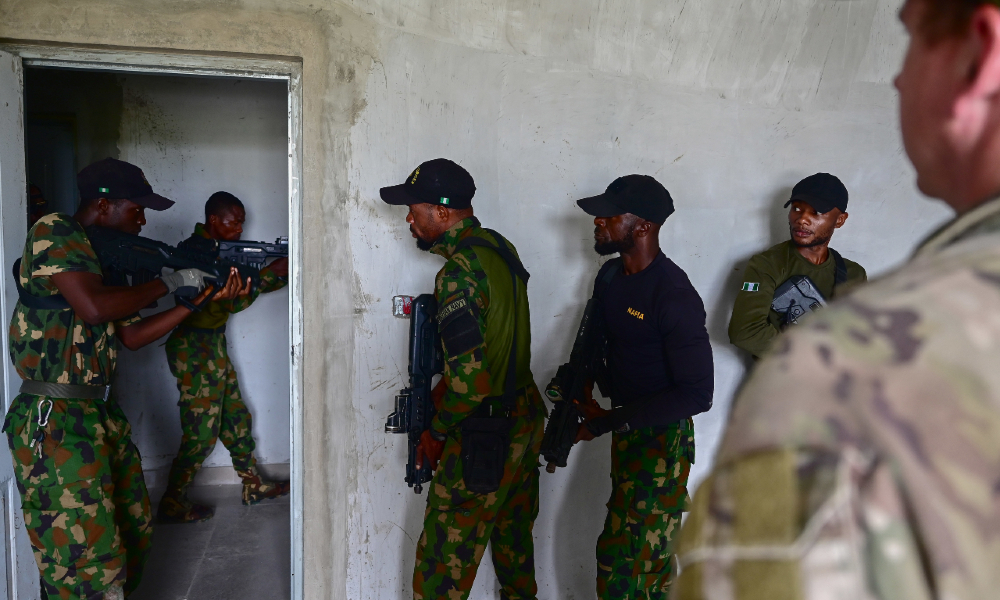A Response to Emptywheel: WMD Charges in White Ideological Violence
Over at her Emptywheel blog, Marcy Wheeler has a response to my piece on the designation and prosecution of terrorism in light of the events in Colorado Spring and San Bernardino. As she notes, we have a lot of common ground, but there are some important differences too. I have a few thoughts in response to her critique.
Published by The Lawfare Institute
in Cooperation With

Over at her Emptywheel blog, Marcy Wheeler has a response to my piece on the designation and prosecution of terrorism in light of the events in Colorado Spring and San Bernardino. As she notes, we have a lot of common ground, but there are some important differences too. I have a few thoughts in response to her critique.
I was a little surprised by Wheeler’s title: “Yes, Calling Only Muslim Terrorists Does Result in Disparate Treatment of Muslims.” I was even more surprised by her statement that I concluded in my piece that “the different treatment of international and domestic terrorism does not result in disparate treatment.”
I am unaware of having reached such a conclusion. In fact, I actually do believe that Muslims are disparately impacted by terrorism laws. Indeed, in my piece I make this point expressly with respect to material support laws. Furthermore, whatever the legal distinctions between homegrown violent terrorists and domestic terrorists—domestic actors with no contact with foreign groups who may or may not be inspired by foreign terrorist ideology—the law certainly applies dramatically different consequences to foreign terrorist organizations and international terrorists who commit crimes in coordination with those organizations. The FBI can pose as Al Qaeda or ISIS operatives and trick a homegrown violent extremist into becoming an international terrorist based on contact with wholly fictitious terrorists. Walk that out to include crimes of attempt and material support, as Wheeler notes, and the disparate application is reflected in the prosecution numbers. There isn’t evidence that the FBI is undertaking sting efforts of similar scope to provide domestic right-wing terrorists with more opportunities to use (or believe they are using) bombs instead of guns in order to bring them within the purview of terrorism laws. There are some such cases, but it’s not on the same order.
More broadly, my analysis of the potential differences in application of domestic terrorism laws acknowledges the risks of creating different charges depending on the ideological motivation of the attacker. So Wheeler is criticizing, apparently, that I do not find strong evidence that this latter risk has materialized to date. She does.
Here, Wheeler raises an interesting point. She notes that in order to fully explore this point, we’d need to not just compare gun crimes to gun crimes (which I did in my piece) but also bomb crimes to bomb crimes (which I did not) and see if there was a disparate application there.
In my article, I note that the investigation and charging decisions fall along a spectrum:
The more international, foreign-directed, organized, bomb-based, and directed against transportation, infrastructure, or government facilities an act is, the more likely it will be investigated and charged as terrorism. The more domestic, solitary, and gun-based an act is, the more likely it will be prosecuted under murder statutes and the less likely is federal jurisdiction over the investigation.
So the question is whether Wheeler is correct that white right-wing males who engage in organized, bomb-based crimes, directed against transportation, infrastructure or government facilities are still not charged under the terrorism statutes. She puts forward a number of examples. Do those cases disprove my point?
A quick review of what qualifies as a weapon of mass destruction for 113B purposes. Under 2332a, a weapon of mass destruction is defined as:
(A) any destructive device as defined in section 921 of this title;
(B) any weapon that is designed or intended to cause death or serious bodily injury through the release, dissemination, or impact of toxic or poisonous chemicals, or their precursors;
(C) any weapon involving a biological agent, toxin, or vector (as those terms are defined in section 178 of this title); or
(D) any weapon that is designed to release radiation or radioactivity at a level dangerous to human life
To be thorough, under section 921:
(4)The term “destructive device” means—
(A) any explosive, incendiary, or poison gas—(i) bomb, (ii) grenade, (iii) rocket having a propellant charge of more than four ounces, (iv) missile having an explosive or incendiary charge of more than one-quarter ounce, (v) mine, or (vi) device similar to any of the devices described in the preceding clauses;
(B) any type of weapon (other than a shotgun or a shotgun shell which the Attorney General finds is generally recognized as particularly suitable for sporting purposes) by whatever name known which will, or which may be readily converted to, expel a projectile by the action of an explosive or other propellant, and which has any barrel with a bore of more than one-half inch in diameter; and
(C) any combination of parts either designed or intended for use in converting any device into any destructive device described in subparagraph (A) or (B) and from which a destructive device may be readily assembled.
In sum, a weapon of mass destruction under the law means a lot of different types of bombs, plus any chemical, biological, or radiological weapon (which also typically manifest as bombs). The most common non-bomb 2332a charges are in anthrax hoaxes (see e.g. US. v. Waagner) These cases—predominantly perpetrated by white males—are a fascinating rabbit hole to go down, but they are not today’s rabbit hole. Those crimes are just too different from mass shootings or bombings to be meaningful to the present analysis. To whatever extent they are relevant, however, those cases support me, not Wheeler. They present additional examples of white males being prosecuted as terrorists under the WMD provision.
That said, 2332a charges are, by and large, about explosives. And Wheeler offers five examples of white, ideologically-motivated bombers who were not indicted or charged under the terrorism statute, in circumstances where they would apparently otherwise qualify.
The first and most notable is Olympic Park bomber, Eric Rudolph. Rudolph is a puzzling case, because the government declined to even indict on terrorism charges that would seem to have been clearly available. But while Rudolph was not charged as a terrorists, federal authorities had long publically referred to him as just that. In a statement following Rudolph’s arrest then Attorney General John Ashcroft called Rudolph’s crimes “terrorist attacks” outright. I don’t have a satisfactory explanation for why the government did not charge Rudolph under 2332, but it does not appear that the reason was because the federal government did not consider him a terrorist. It called him one repeatedly.
Wheeler notes an additional 4 cases:
Then there’s another Sally Yates case (this time as US Attorney), the Waffle House plot, in which four geriatric right wingers plotted to use weapons and ricin dropped from a plane to overthrow the federal government. They actually bought what they thought was explosives from the FBI, but did not get charged with terrorism for either the ricin or the presumed explosives.
There’s Schaffer Cox, who got busted for conspiring to kill federal authorities; he talked about using grenades but did not get charged with a WMD count. There’s Benjamin Kuzelka, the guy with Nazi propaganda trying to make TATP. There’s William Krar, the white supremacist caught with massive explosives who eventually pled to one chemical weapons charge, but without exposing what was presumed to be a broader network.
Of these cases, Benjamin Kuzelka strikes me as falling squarely within the non-terrorism end of the spectrum. Yes, his crime was bomb-based, but there is no evidence as to his intended target and he clearly checks the boxes of domestic, solitary, and not organized or otherwise directed.
Conversely, the Waffle House case, Schaffer Cox, and William Krar do challenge my thesis. Based on the public facts, it would seem those cases could have qualified under the terrorism statute—and were organized, bomb-based, and directed against the government—but were not charged as such.
This point conceded, I am not quite ready to concede that these examples disprove my point, in light of others which support the spectrum analysis.
Wheeler acknowledges three examples where non-Muslims were indicted on terrorism charges: MLK bomber Kevin Harpham, the Hutaree group, and the Occupy Cleveland case, US v. Wright. But she also missed a couple, including a bit of a whopper: Oklahoma City bomber Timothy McVeigh, who faced 2332(a) charges among many other.
There’s also Eddie Garey who was indicted under 2332a for making a series of bomb threats. That case seems a bizarre reach to the terrorism statute—and applied to a white guy—since Garey made the threats to extort money and not for any apparent political goals.
I cannot claim any of this represents exhaustive research on the subject. But by my count, that leaves us tied 5-5 by way of examples and counterexamples. There are also Muslims who planned to use bombs for ideological violence who have been charged under the ordinary criminal code, not terrorism statutes. For example, there’s U.S. v. Mandhai (375 f.3d 1243), in which the defendant planned to bomb electrical transformers in Florida in retaliation for the US government support of Israel and other countries that oppress Muslims. Mandhai was charged under 18 USC 844—exactly the same as Eric Rudolph.
Add in the fairly compelling evidence that the law is evenly applied to ideological gun crimes, which Wheeler does not seem to contest, and I believe my premise generally holds. The states have the capacity and are better suited to prosecute an array of ideological violence. The federal government steps in to assert jurisdiction—and invoke terrorism statutes specifically—based on some calculation regarding the foreign and international connections, whether the crimes are directed against specific federal interests, and if bombs are involved. And that holds true for both Muslims and right-wing militants. Yes, Muslims are far more likely than right wingers to satisfy international and foreign-directed criteria, and this does create a disproportionate impact. But the underlying federalist construction remains a rational one, and there’s danger in letting this disproportion justify creating more domestic terrorism offenses.
Finally, I want to note Wheeler’s criticism that
the most alarming claim that Hennessey makes, in the midst of an argument that the civil liberties cost of treating domestic terrorism like international terrorism is too high: that what she calls “complex legal obligations” on using “incidental” collection reflects heightened privacy concerns
And her position that
For incidentally collected US person data that resides in FBI’s databases, in other words, there are no complex legal obligations on incidental collection. None. It just sits there for 30 years at potential risk of contributing to a prosecution.
I can’t comment on anything related to that in the specific. But I stand by my original comment.





